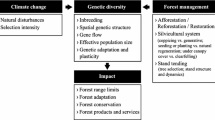Abstract
Climate change triggered forest die-back is a huge concern worldwide. Arboretums and common gardens comparing geographic origins within species can provide a large body of valuable information and material usable to increase forest resilience. Common gardens have been foundational in demonstrating the existence of genetic diversity, local adaptation and phenotypic plasticity. They have also been instrumental for forest management and policy, e.g., for guiding seed transfer rules and their marketing. While the current generation of common gardens has seen a renewed interest for developing process-based niche models or genome-trait-environment association studies, they are too limited in the number of species, provenances and habitats they sample in the context of climate change and novel bioeconomy focus. A new generation of common gardens is now needed.


Similar content being viewed by others
References
Fady B, Aravanopoulos F, Benavides R, González-Martínez S, Grivet D, Lascoux M, Lindner M, Rellstab C, Valladares F, Vinceti B (2020) Genetics to the rescue: managing forests sustainably in a changing world. Tree Genet Genomes 16(6):1–11. https://doi.org/10.1007/s11295-020-01474-8
GEN4X (2021) Details on the INRAE common garden network GEN4X can be accessed from two files in an open ccess repository: https://doi.org/10.15454/50RS8C and https://doi.org/10.15454/MQKQ1O
Langlet O (1971) Two hundred years genecology. Taxon 20:653–721
Martínez-Sancho E, Rellstab C, Guillaume F, Bigler C, Fonti P, Wohlgemuth T, Vitasse Y (2021) Post-glacial re-colonization and natural selection have shaped growth responses of silver fir across Europe. Sci Total Environ 779:146393. https://doi.org/10.1016/j.scitotenv.2021.146393
Médail F, Monnet AC, Pavon D, Nikolic T, Dimopoulos P, Bacchetta G, Arroyo J, Barina Z, Cheikh Albassatneh M, Domina G, Fady B, Matevski V, Mifsud S, Leriche A (2019) What is a tree in the Mediterranean Basin hotspot? A critical analysis. For Ecosyst 6:1. https://doi.org/10.1186/s40663-019-0170-6
Popkin G (2021) Forest death. Science 374:1184–1189. https://doi.org/10.1126/science.acx9735
Prasad A, Leites L (2021) Ecological analysis of intraspecific variability of eastern white pine (Pinus strobus) under climate change by combining provenance and demographic data. Landsc Ecol. https://doi.org/10.1007/s10980-021-01333-4
Vinceti B, Manica M, Lauridsen N, Verkerk PJ, Lindner M, Fady B (2020) Managing forest genetic resources as a strategy to adapt forests to climate change: perceptions of European forest owners and managers. Eur J For Res. https://doi.org/10.1007/s10342-020-01311-6
Acknowledgements
This research was part of the GenTree project which has received funding from the European Union’s Horizon 2020 Research and Innovation Programme under Grant Agreement # 676876.
Author information
Authors and Affiliations
Corresponding author
Additional information
Publisher's Note
Springer Nature remains neutral with regard to jurisdictional claims in published maps and institutional affiliations.
Rights and permissions
About this article
Cite this article
Fady, B., Rihm, G. Arboretums, common gardens and forest tree resilience. New Forests 53, 603–606 (2022). https://doi.org/10.1007/s11056-022-09908-y
Received:
Accepted:
Published:
Issue Date:
DOI: https://doi.org/10.1007/s11056-022-09908-y




